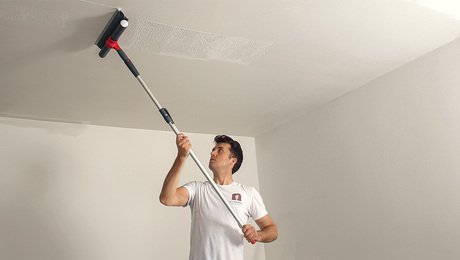Moving the Electic service head
I want to move my service head over about four feet and put a door where it runs now. Before I get an electrictian out here and potentialy waste his time, what is the very rough did-it-before-for-this-much ballpark? What shoould I look out for, like splicing an extension on, or running whole new line, or messing with the drop?
I’m in Baltimore.
thanks in advance,
Steve


















Replies
Please post a picture.
Its not as good as a pic, but all I have until I get a new cameraI want to get the service head (red line) moved around the corner, and maybe raised above the roof line, and encased in conduit. It is currently just heavy cable. The blue line is the drop. There is also an older drop (from the pole to the house) that just ends underneath the roofline a few feet away. I want the power co. to remove it, they say its all mine.
Hi Steve,
About moving service drops and weatherheads:
The utility company will have their say about what they are willing to do based on where the pole is in relation to the house.If moving it around the corner of the house,then they'll probably say you have to install a ridgid conduit mast through the soffit,maybe even with guy wire supports.It isn't THAT hard to do a roof penetration,install a boot,anchor the ridgid conduit,etc.but just realize it can't be as cheap as just replacing what's there.
As far as adding the door and just moving the service over,keep these rules in mind:you'll have to maintain 10' of clearance above any sidewalk or steps to the service conductors.Also you have to have 3' of clearance to any window or door.Got enough room?
If you're moving your meter and service entrance farther away from the panel,you might have to add a disconnecting means outside.The goal is to have a minimum of unfused cable or wire inside your house before it is protected by the main breaker in the service panel.
Changing from an overhead to an underground service would give you the nicest looking job,but would be the most work and money.I don't think the power company would spring for the digging,and installing new underground conduit or cable but you could ask.The cost of wire and cable right now is EXTREMELY high.
So how much? Pricing isn't my end of it,but I'd have to guess you have as much work as a service change,maybe even a little more.$1000>x<$2000?
Barry
Edited 5/11/2005 9:38 am ET by IBEW Barry
Barry et al, thanks for the detailed replies. One reason I want to move it, or at least raise it, is because I can currently touch the drop from outside my door now.So what do y'all recommend as my next step-1. A licensed works for himself electrician.2. A lager company with bucket trucks.3. The power co. BGE
Steve,
Well of course I'd like to see you hire an IBEW/NECA contractor, but I realize that in some areas of the country they aren't as prominent.Getting an experienced small shop electrician would serve you well.He can tell you how much he can do and how much the power company will insist on doing.Good luck.
Barry
When I needed to move mine, I was able to have it undergrounded and for just a little extra money--got rid of an ugly wire and a hazard.
I like that idea. Would make painting the house much easier and safer. Mind me asking what the money was? And how far it runs?
Did you get an electrician, a large company, or did the power co. do it?
Thansk
Steve
My electrician rented a trencher and did it for me when he was doing a bunch of other work for me about five years ago. Since they were doing a new panel and meter socket, etc. and I was willing to wait until they needed the trencher for another job, they made me an offer that seemed pretty good at the time. Can't recall a price now though.The utility pole is about 60 feet from the service entrance. The big wire now runs in conduit down the pole and into the ground. Another short run of conduit runs up out of the ground to the meter on my house.
$2000 tops! read on...
i'm no electrician, but i installed both service entrances for my duplex. setting the new conduit, weather head and meter box (MB is free in indianapolis if you go to the electric company) and pulling wire from the new splice to the main breaker should be a piece of cake.
cutting through the roof soffit (should you still want that) might be interesting depending on access.
once the new service is set, pull the meter, connect the new line to the main breaker and have the electric company complete the new drop (should be 'free' as well). the cable is kind of pricey, but 2 guys can knock this out in a day. that's $800 at $50 an hour. plus $500 in materials max. so revised that would make it $1300. don't you love when the quote keeps coming down?
obviously this is a bit tongue in cheek -- i hope none of the professionals scoff at the explanation. you might want to think about adding a shut-off between the break and house panel. you can then eliminate the conduit from the shut-off to the main (if you WANT to) as well as have a way to turn the power off and work on the main panel without calling the electric company. add $100 bucks. ; ) also, deduct $50 for taking care of demo'ing the old meter box and wire.
j
think about adding a shut-off between the break and house panel
I found out that here in Virginia it is the law that you now must put a shut off switch right under the meter before it runs to the panel in the house. This is to be done on any new construction or any time an old meter must be moved. One one house that I have it has 60amp service. When I replace it with 200amp I must put in one of those switches.
There reason for it is so the fire departments can shut off the power if need be instead of waiting for the power company to show up to do it at the top of the pole.
DaneI will always be a beginner as I am always learning.
Dane,
Are you prohibited from putting a lock on the exterior breaker enclosure then? I know it sounds like a good idea for firemen,but it does pose other potential problems.If a bad guy wants to do you harm he can start by killing your lights and an unbacked up security system.Or,if your dog craps in the neighbor's yard,they can wait for you to go on vacation,kill your power during the week,and let you come home to a fridge and freezer of spoiled food.
I've been following your project.I'd give you a hand if I lived closer,it looks like a cool project and you could certainly use the help.Don't burn out or let it get to your marriage.It can be overwhelming.
Barry
I never thought to ask the power company man about locking that external emergency breaker. There might be a lock that you would have to buy from the fire department were they would have a key that would fit all of the locks that is put on in a given area. Can you imagine the size of the key ring they would have to have to hold all of the keys if every body put there own lock on and then supplied the fire department with a key? They would spend forever trying to find the key for that lock. Would be faster to have the power company shut it off at the pole.
I appreciate the offer of help. Here is a project that I could use some help on. http://forums.taunton.com/tp-breaktime/messages?msg=55246.1 I have to go back over there next week and do some work on it. Jack up the support under neath the bath tub and fix some more plumbing. Then it will at least have cold water.
Well I need to get to bed. Have to work on my van tomorrow. One corner of the radiator has come loose from its mount. If it isn't one thing then it is something else.
DaneI will always be a beginner as I am always learning.
Every fire department has a "universal key"..."Snip". Bob's yer uncle...; )
A person with no sense of humor about themselves, has no sense at all.
Interestingly in some parts of the country it is standard, manybe required, to have the whole panel on the outside of the house.I believe that So Cal is like that.But in addition to security I have heard stories of people going into older neighborhoods and stealing breakers from obsolete brands. The ones where replacement breakers go for 50-100.I have noticed two remodels in my area where they have stuck on external disconnects. Don't thing that there is a new requirement for them. But they where both done by the same company and that might be there standard. With aobut 6 power companies and each city having there own code them might automatically go for the worse case. But layout from where the entrance is to the panel might have been too far, sepcially in the 2nd one. But that is just seeing them from the outside.
Edited 5/12/2005 8:35 am ET by Bill Hartmann
There reason for it is so the fire departments can shut off the power if need be instead of waiting for the power company to show up to do it at the top of the pole.
Seems kinda silly to me. Around here, when the fire dep't shows up, they just clip the seal on the meter ring, and pull the meter - no power to the house.
My utility has pretty detailed specs online about their requirements for services, bith aerial and underground. Some of them are pretty subtle; i.e., they discourage placing the meter in a location that requires the meter reader to walk past bedroom windows, for privacy reasons.
I've put in a couple of services on my farm, and I start with a call to the utility. they send out a consultant and OK the location, let m know if guy wires are really needed, etc. Then you pull the permit, do the work, & get it inspected. The utility will then do the install once you hve the county inspection sticker on the meter base.
There are a lot of variables here. Depending on where you live, the utility co will practically do it for you for a nominal charge, or they'll stick you with a hefty fee for hardly doing anything.
Since you're moving the head farther away from the panel, and you don't indicate a disconnect on the outside anywhere, you may need to run new cable all the way from the head to the panel.
You may be moving the head so far from the panel that a disconnect is now required between them.
Now that you know there are a number of factors to the job, such as, height above ground and above ground over different parts of the property or sidewlk or driveway or street, additional disconnect requirements , masts, etc., it would be prudent to bother a licensed electrician who would be familiar with the code requirements in your area and "waste" his time to get the exact parameters of the job.
Note also that if the angle that the new service wire takes after moving the service causes the wire to impinge on (over) the neighbors property line, the code will probably disallow the move.
A service change I had done recently was $1,350. It included the new can, disconnect, mast, ground rods and required wiring back to the panel.
Some jurisdictions are tight enough to make you move the panel to back up to the new can and disconnect or severely limit the distance you can be from the disconnect.
Did someone also mention required clearances from windows and doors?
Steve:
In Baltimore, you can't do anything yourself without a permit. The NEC says a service panekl must be located as close as possible to where the service cable enters the building, since it is not fused.
To answer your question, a friend in Anne Arundel Co. (same area) needed new service, since her entrance was 100 amp and I recommended a complete new service panel with upgrade to 200 amp. She didn't have a lot of cash, so I suggested BGE, since they let you put the expense on your electric bill and pay over three years.
She got a new service entrance, meter, panel, all new breakers, and a new wire from the pole to the service, upgraded to 200 amps, for $1700.00. If your serv ent. is old or 100 amp, that will be money well spent. If you just need to move the service entrance, I'm sure it will be cheaper.
I wouldn't try anything like this myself! I asked the question to get some advice of what to talk to the pros about and to make sure it wasn't so out of the question.
Thanks to all for the advice! It sounds doable and reasonable. The new head will only be a few feet from the old, literally around the corner, and the drop will not interfere with any property lines or window/door easments. I am also going to have a service disconect installed. I should begin the project in a month, will post pics when done.
-Steve
Here is a summary of the spacing requirementshttp://www.codecheck.com/pg25_26electrical.html#serviceconductors